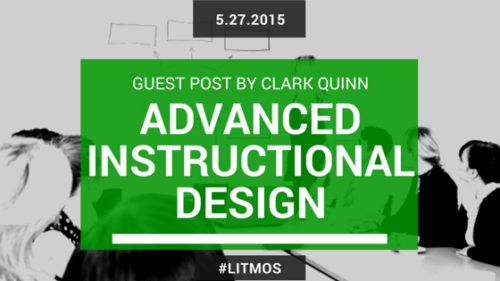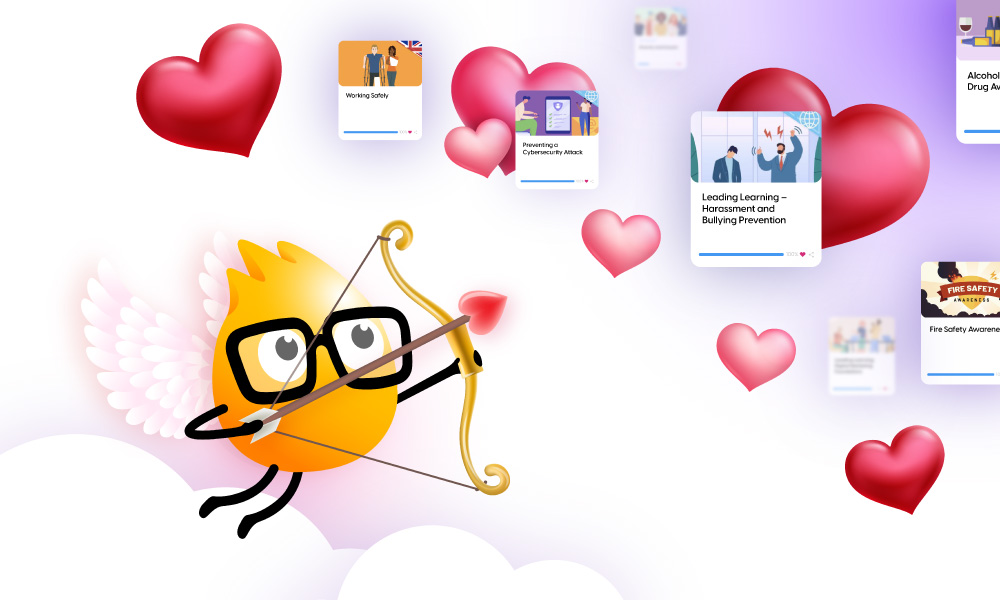GUEST POST by Clark Quinn: Thoughts on Advanced Instructional Design
I recently reviewed an online course on instructional design. And it had many of the things you’d expect: overview of pedagogies, starting with good objectives, interactions, design processes, storyboarding, project management, etc. But what it didn’t do was go very deep on learning design, and I think this is a problem.
Review of Basic ID
Let me go back further: when I first came into the industry, out of academia and heads-down on a research project, I was excited. Here we had great knowledge of how to do good learning, and here in the corporate world we had real needs and real resources; this was going to be great. I slowly realized that the state of learning design was woefully inadequate, and that hasn’t changed in over a decade of work. I ended up creating an Advanced Instructional Design course not because I wanted to, but because it was so needed!
The basics are twofold: one is to go deeper into the cognitive processes of learning (no, this isn’t brain science as is so widely touted and misused, though it is based upon the deepest research), and the second is to elegantly integrate the emotional components. These have implications for every component of a learning experience from introduction, through concept, practice, and example, to your summary. And I’d really like learning designers to ‘get’ this and start designing accordingly. That is, if you want to do good learning…and if you don’t, why are you in this job?
Good ID Starts with Good Objectives
It starts with good objectives, of course. You need to make sure what they’re learning to do is what they need to be able to do in the workplace, so the objectives have to be about ‘do’, not ‘know’. (If it’s just knowledge, can it be in the world in the form of job aids, not in the head?) And you’ll want the outcomes to be measurable, to evaluate whether they can do it, and whether it’s impacting important business measures. In short, align the learning with the business need. You’ll have to work harder with your SMEs, since they don’t have access to all of what they do, but working with several at a time and reality-checking by observation are a couple of tricks.
From good objectives, you can develop the right practice, and that is the immediate next step. Good practice has some important features: it’s contextualized, it’s sufficient, and it’s challenging. First, learners shouldn’t be tested about arbitrary knowledge, they should be put into situations like they’ll see in work and asked to make the decisions that they need to make better to improve the business outcomes. We also have to get beyond “practice ‘til they get it right” and give them practice until they can’t get it wrong. This includes spacing the learning out over days, because massed practice doesn’t persist. Moreover, the alternatives to the right answer can’t be trivial. The mistakes learners make typically aren’t random, and we need to find the reliable ways they misunderstand and make those alternatives available and plausible, so they make mistakes in the learning situation, not on the job. Finally, we need to exaggerate the stories in the learning experience to mimic the pressure that the real job brings. This is where we start adding in the emotional element.
Provide Learners with Mental Models
To guide the performance, we should be providing the learners with mental models. While providing rote steps works when the work never changes, that’s almost never the case (and if it does, automate it!). In general, however, giving people conceptual and causal models that justify why it works this way provides a better basis for adapting the performance in unusual or uncertain situations. Typically, when we ask people to do X before Y, there’s a reason. If we provide the reason, we give them a better basis to make decisions in the face of change. And that ability to adapt in the face of change is going to be the hallmark of organizations that can thrive. Diagrams or animations are powerful ways to communicate models, and when used in context help learners understand how those models are used to guide performance.
Which is where examples come into play. The point of a good example is to show how a concept should (or should not) guide performance in context. It should have a story setting, since our brains are wired to comprehend stories, and it is a nice way to illustrate the challenge, the approach, and the outcomes. The story should explicitly show the underlying thinking that accompanies the solution (something experts are often poor at doing when working problems, yet really valuable for the learner), so that how the concept is applied is made clear. A harder, but even more valuable trick is to show the ‘hero’ trying something, recognizing it’s not working, and revising the approach. This exposes how ongoing monitoring during the process works, and helps the learners internalize that monitoring and become self-improving performers. By the way, in addition to videos with voice-overs, graphic novel formats are a highly globalizable and localizable medium for telling examples, stripping away irrelevant context and using thought bubbles to convey the inner thinking. Of course, audio narration can work well too, particularly to space out examples over time and be used while commuting.
A note about the contexts used in the examples and practice. The process of abstraction that yields to transfer to new situations is dependent on the breadth of contexts seen. For instance, if you only show how to interact with customers, learners might not think to apply it to their working relationships, and that’s a missed opportunity for generalization and improvement to other aspects of the business. The implication is to choose contexts that span the space of applicability, (and, of course, negative examples outside of it). Our SMEs here can help us by providing stories of spectacular wins (or losses) that can be used to illustrate how the concepts play out in action. The choice of contexts for examples and practice should be ones that integrate several elements: they illuminate particular facets of application, between them they span the space of application, and they’re intrinsically interesting via their relevance to the learner.
Emotional Engagement in ID
This last element crosses into the next topic, that of emotional engagement. We should be looking to design an experience, not just content or learning. We should hook learners emotionally as the very first element, because that’s the way to ensure that they’ll bear with us as we proceed. We can exaggerate the consequences of having the knowledge, or not, and we can do it humorously or dramatically, but we want a visceral reaction of “oh yeah, I do need to know this”. We should also help them see where what they’re doing fits into the world as a whole, drilling down from the big picture to what they’re accomplishing here, to maintain associations with prior knowledge and motivation. We should continue the emotional aspect by, again, using interesting contexts, but also being minimal in material and providing challenging practice (aka ‘hard fun’). Our conclusions should close the emotional experience as well as recognize the cognitive outcomes. We should acknowledge learner effort and accomplishments, and reconnect them to the world.
We should also explicitly consider the emotional trajectory of the experience. If learners are likely to be anxious, we should reduce that. We should build their motivation, explicitly. And we should work to gradually build their confidence (and remove it if they’re too far over to begin with). Finally, we should help them manage their expectations, we don’t want a large mismatch between what they are thinking they’ll experience and what they will actually experience, certainly not on the negative side.
I’m skipping a lot of stuff I’m taking for granted: that you’ll understand your audience, create interim versions to test, use good project management, and more. But the elements depicted here will help make the difference between just well-produced learning and well-designed learning. The nuances are subtle, but once you get used to this it shouldn’t take longer, and it will work better. When we couple details derived from decades of research on learning with an explicit consideration of the emotional experience, we can create learning that will actually impact the business in productive ways. And that is, ultimately, what we can and should be doing.






